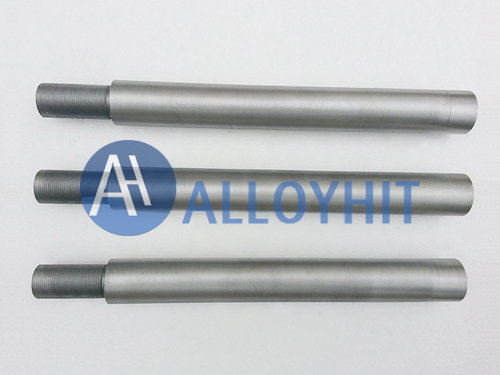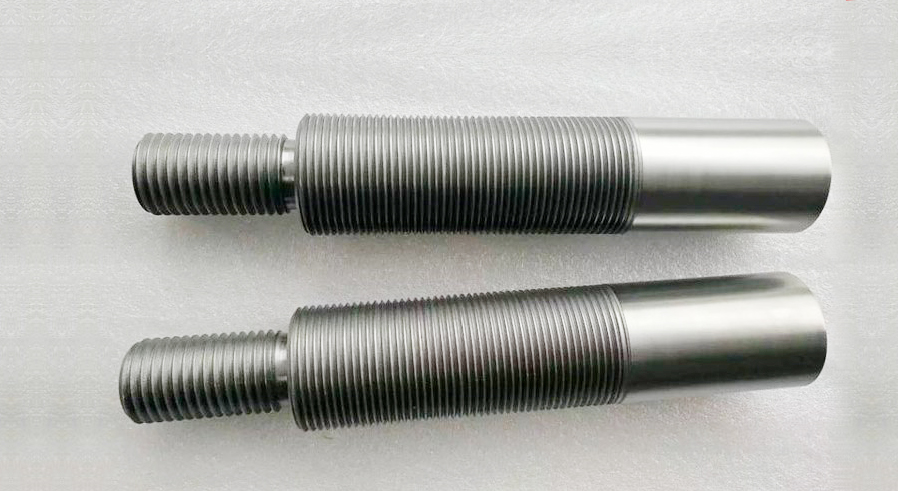
Electrode density comparison
| Electrode | Size | Density |
| Pure molybdenum electrode | Ø 30.0 - 101.0 mm | >10.0 |
| Ø ≥ 101.0 mm | >9.90 |
Comparison of chemical properties of Molybdenum Electrodes
Molybdenum is corrosion-resistant when the atmospheric humidity is below 60%, and will only show slight oxidation at higher humidity.
Molybdenum is no longer corrosion resistant in alkaline and oxidizing liquids at temperatures above 100°C.
For applications using Molybdenum in oxidizing gases and elements above 250°C, Alloy Hit develops anti-oxidation coating electrodes to prevent the Molybdenum Electrode from being oxidized.
Glass solutions, hydrogen, nitrogen, inert gases, metal melts and oxide ceramics will not attack Molybdenum even at very high temperatures.
| Greater than 60% humidity(higher temperature) | Alkaline/oxidizing liquid below 100℃ | High temperature oxidizing atmosphere | Glass solution | Metal solution/oxide ceramic |
| Slightly oxidized | preservative | Si, Mo based anti-oxidation coating | Does not corrode | Does not corrode |
Alloy Hit's Molybdenum Electrodes are all made of powder metallurgy of Molybdenum powder with a purity of more than 99.97%. They have good machining performance, formability and welding performance, and their deformation is more than 60%, and are then machined.
In terms of dimensional tolerances or machining, Alloy Hit can fully meet customer requirements.
Features of Molybdenum Electrode
Covering all specifications and sizes, the maximum diameter can be 203.2mm
Using forging process, long service life
High purity, melting point 2620℃
High electrical and thermal conductivity
Corrosion resistance and good stability
Excellent creep resistance

Electrode composition comparison
| Item | Unit | ASTM B387 | Control Value | Alloy Hit Valule |
| Main chemical content | % | ≥99.95 | ≥99.97 | ≥99.97 |
| Al | ppm | / | ≤10 | 1 |
| Cr | ppm | / | ≤20 | 3 |
| Cu | ppm | / | ≤20 | 2 |
| Fe | ppm | ≤100 | ≤20 | 10 |
| K | ppm | / | ≤20 | 10 |
| Ni | ppm | ≤50 | ≤20 | 10 |
| Si | ppm | ≤100 | ≤20 | 10 |
| W | ppm | / | ≤300 | 169 |
| C | ppm | ≤100 | ≤30 | 13 |
| H | ppm | / | ≤10 | / |
| N | ppm | ≤20 | ≤10 | 5 |
| O | ppm | ≤70 | ≤40 | 40 |
| ZrO2 | % | / | 1.68±0.17 | |
Comparison of Electrode physical properties
| Item | Temperature/℃ | Value |
| Melting point | / | 2623℃ |
| Resistivity /Ω.m | 20 | 0.07 |
| 500 | 0.18 | |
| 1000 | 0.32 | |
| 1500 | 0.45 | |
| 2000 | 0.59 | |
| Thermal conductivity /W/(M.K) | 20 | 143 |
| 400 | 127 | |
| 800 | 117 | |
| 1000 | 98.8 | |
| Thermal expansion coefficient /1/K | 20 | 5.1 |
| 400 | 5.4 | |
| 600 | 5.6 | |
| 800 | 5.8 | |
| 1000 | 6 | |
| 1200 | 6.2 | |
| 1400 | 6.4 |
Electrode performance comparison
The following data takes an electrode with a diameter of Φ76.2mm as an example.
| Electrode | Temperature /℃ | ASTM | Alloy Hit | ||
| Tensile strength /MPa | Elongation after break % | tensile strength /MPa | Elongation after break % | ||
| Pure molybdenum electrode | Room Temperature | 450 | 10 | 486 | 15.7 |
Electrode high temperature durability performance
| Electrode | Size | Alloy Hit |
| Pure molybdenum electrode | Ø 50.8mm | deformation 0.37% |
| At 1200℃, 200MPa stress, 1000 hours | ||
Electrode recrystallization performance comparison
| Electrode | Size | Deformation 60% | Deformation 90% |
| Pure molybdenum electrode | Ø 50.8mm | 1250℃ | 1100℃ |
Features of Molybdenum Electrode
1.Coating composition: Si, Mo (coating containing these two elements can achieve anti-oxidation effect, and impurities may be introduced when too many elements are added);
2.Structure after coating: substrate, transition layer, coating, self-healing layer;
3.3000 hours, 1200℃
500 hours, 1400℃
72 hours, 1600℃


 +86 13120915623
+86 13120915623